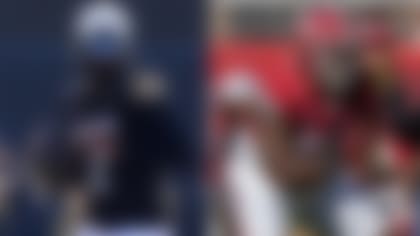Any time you have a quarterback at the top of the NFL draft it has to be considered a good year, and this year's draft is a good one.
After Sam Bradford, it's anyone's guess as to where Jimmy Clausen winds up and how many quarterbacks go in the first three rounds. Teams have given us an indication of this year's QB depth with the offseason moves to acquire Donovan McNabb, Charlie Whitehurst, Seneca Wallace, Brady Quinn, Shaun Hill, and spending money on Derek Anderson and Jake Delhomme in free agency. Those won't be the last quarterbacks to have new homes in 2010; some team will trade for or pick up Jason Campbell, who is sure to be gone in Washington.
The 2009 quarterback class put three starters on the field as rookies (Matthew Stafford, Mark Sanchez and Josh Freeman -- all first-round picks), but I don't think this group will come close to that performance or production. On a scale of 1-10, the 2010 quarterback class gets a six. Bradford, Clausen, Colt McCoy, Tim Tebow, and Tony Pike lead the way, and my guess is only one steps on the field in 2010 as a starter.
Player with most upside
So many of the quarterbacks in this draft class come from programs that run the spread offense. Some of them struggle to take a snap under center and really have never had to read coverages the way an NFL quarterback has to on every snap. Clausen won't struggle because he comes from a traditional NFL-type offense, and the more prepared a QB is when he first steps on the field goes a long way to creating a path for success. But a guy who impressed me at the Senior Bowl and again when I watched his game tapes, especially the one against Oregon State (31 of 49, 332 yards, 2 TDs, 1 INT), is Pike of Cincinnati. He is tall (6-foot-6), mobile, a good decision-maker, and still developing his trade.
He needs some physical strength development, which NFL people will tell you is the easiest thing to fix. Pike threw 49 touchdown passes in 19 starts at Cincinnati could be the next Joe Flacco.
Biggest boom-or-bust prospect
A number of well-respected football people have an opinion that Bradford has Troy Aikman-like qualities, and his boom-or-bust label is about staying healthy. Tebow is the guy who fits this category best. After having possibly the greatest career in the history of college football, scouts raised some real questions about his arm at the NFL level after his performance at the Senior Bowl. He has worked hard to fix the issues, but no one knows for sure if his new mechanics hold up until he's under fire in real-game situations. His father says he's a top-15 pick; most NFL people think the second round is a more likely spot. But whoever takes Tebow will have a media circus surrounding the team and instant pressure on the incumbent starter, particularly if he doesn't become an elite quarterback.
Gil Brandt's scouting report
Tim Tebow, Florida
Tebow is going to be a lot better quarterback and player than we have given him credit. He's taken a lot of shots. I do believe you can make him into a passer. It worked with Roger Staubach. I wouldn't be a bit surprised to see Tebow selected somewhere around 20 in this draft. You've got to look at him and see what he's going to be a year or two from now, and I don't think you'll have to worry about him not working hard in order to progress.
My favorite sleeper
Two quarterbacks have to be considered here: Jonathan Crompton of Tennessee and Mike Kafka from Northwestern. Crompton is a one-year wonder under the guidance of Lane Kiffin, who spent just one year with him. He wasn't invited to the NFL Scouting Combine in February, threw a total of nine touchdowns the previous three seasons, but hit the end zone 27 times in 2009. Crompton's big and athletic enough to make an NFL team, and sitting on a bench for a few years can only help.
Kafka is strong, can escape, and has played in a situation where his team was not the best on the field most weeks. He has a lot of experience leading Northwestern from behind and pulled out victories three times last year. Kafka is another shotgun, spread QB that needs time to develop NFL skills, but he may have the intangibles to be successful down the road. Both quarterbacks should be late-round picks or even undrafted free agents that surely will find themselves on a practice squad to start their pro careers.
Player with most to prove
McCoy did it all in college, and he put up big numbers en route to becoming the winningest signal-caller in college football history. His 70.3 percent career completion rate may be misleading in the offense he ran at Texas, but the 112 touchdown passes in 52 starts can't be denied. He looked good at his pro day, but NFL coaches don't fall for the manufactured dress rehearsal in shorts. McCoy has a lot to prove in the NFL, and like the man he is regularly compared to, Drew Brees, should go in the second round.
Any West Coast offense team that features a short-rhythm passing attack gives him the best chance to succeed. McCoy is a winner but needs to learn to deal with blitzing defenses, reading coverages and finding open receivers rather than taking off and running. He ran for more than 1,500 yards and 20 touchdowns in college, but in the NFL he'll need to win with his feet only after the passing opportunities are exhausted.
Small-school prospect with a chance
The most intriguing small-college prospect to catch my eye at the combine was Fordham's John Skelton. He threw the ball better than any of the quarterbacks in his group, and after he measured close to 6-6 and 243 pounds and ran a 4.85-second 40-yard dash, there is a lot to like about his future. Coming out of high school he reportedly was headed to Texas Tech, but instead ended up in the Bronx at a Football Championship Subdivision (formerly Division I-AA) school.
He needs work against better competition, better mechanics and decision-making, but he's worth a late-round pick. A patient quarterback coach who wants to work with a guy who may have more raw talent than most of his draft class will be rewarded.
Debunking a myth
Be careful what you read these days about any draft-eligible quarterbacks. So much is speculation, and here are a few examples:
» Bradford is not durable. The St. Louis Rams, who looked poised to take Bradford with the top overall pick, seem satisfied he is as durable as any other QB in the draft. Sure, he could get hurt again, but so did Sanchez and Stafford in their rookie seasons, and they didn't enter the league with medical red flags.
» McCoy doesn't have the arm strength to play in the NFL. Chad Pennington won an awful lot of games with a "weak" arm, and Joe Montana was no gunslinger.
» My personal favorite: A college spread QB can't play in an NFL system. Have you noticed how much of the University of Florida passing game the New England Patriots have incorporated into their offense? NFL teams are in a lot of shotgun packages, and some of these quarterbacks who have run the "spread" will succeed at the NFL level as they meet the offenses halfway.
Teams with the greatest need
The Redskins just took care of their quarterback need by trading for McNabb, but that still leaves the following teams hoping this draft satisfies a need at the most important position in football. Most teams are drafting a quarterback they can develop for the future and not necessarily a guy to march out on the field the first week of the season. St. Louis, Buffalo, Cleveland, Jacksonville, Oakland, Carolina, San Francisco, Minnesota, and even Pittsburgh have to be looking closely at this QB class.



